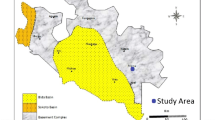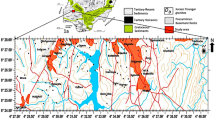Abstract
Geophysical investigation was carried out in some part of Ajaokuta metropolis to identify the rock types and their conditions in relation to groundwater prospectivity of the area. The geophysical survey was carried out using Vertical Electrical Sounding (VES) on 10 (ten) sounding points. The acquired data were interpreted with results showing four to five lithologies consisting of the topsoil, with resistivity values ranging from 37.9 to 515.9 Ωm and an average thickness of 0.8 m. The weathered layer below the topsoil has range of resistivity values from 42.3 to 415.8 Ωm with average thickness of 3.0 m while the resistivity values of the highly weathered granites/fractured basement range from 41.7 to 274.8 Ωm with thickness values varying between 5.0 and 27.0 m. Due to the significant aquifer thickness around this area, it is considered very promising for groundwater development. The bedrock (fresh basement) underlies the study area and is characterized by resistivity values ranging from 880.7 to 66,860.3 Ωm. The VES curve types typical of the area are HA, AA, HK, and KHA, with the HA curve type being the most predominant. The computed resistivity contrasts at the interface of the fresh basement rock, and reflection coefficients indicated that the study area is most likely characterized by fractures that are highly saturated with water since their resistivity contrast and reflection coefficient values are less than 19 and 0.9, respectively. Longitudinal conductance (S) and total transverse resistance (T) were also determined for the area. The highest T values were determined at VES location 2 (35,491.7 \({\text{Ohm - m}}^{2}\)) and VES location 8 (23,240.8 \({\text{Ohm - m}}^{2}\)), and this therefore means that the water bearing rocks at these VES locations most likely have the highest transmissivity around the study area. The computed S values were used to infer the overburden protective capacity of the area. The results indicated that, apart from VES 1 location with S value of 0.655 mho, which has a moderate protection, the study area generally has poor to weak overburden protective capacities (within the range of < 0.1 mho and 0.1–0.19 mho), thereby making the aquifer around the area exposed to contamination or pollution in the event of hydrocarbon pollution, percolating fluids or movement of contaminants from adjacent contamination sites.












Similar content being viewed by others
References
Adagunodo TA, Sunmonu LA (2012) Geoelectric assessment of groundwater prospect and vulnerability of overburden aquifers at Adumasun Area, Oniye, Southwestern Nigeria. Arch Appl Sci Res 4(5):2077–2093
Adagunodo TA, Akinloye MK, Sunmonu LA, Aizebeokhai AP, Oyeyemi KD, Abodunrin FO (2018) Groundwater exploration in Aaba residential area of Akure, Nigeria. Front Earth Sci 6:66. https://doi.org/10.3389/feart.2018.00066
Adeniji AE, Omonona OV, Obiora DN, Chukudebelu JU (2014) Evaluation of soil corrosivity and aquifer protective capacity using geo-electrical investigation in Bwari basement area; Abuja. J Earth Syst Sci 123(3):491–502
Adesida A, Fatoba J (2004) Electrical resistivity survey for conductive soils at gas turbine station, Ajaokuta, SW, Nigeria. Glob J Geol Sci 3(1):55–59
Adeyemo IA, Olowolafe TS, Fola-Abe AO (2016) Aquifer vulnerability assessment at Ipinsa-okeodu area, near Akure Southwest Nigeria, using GODT. J Environ Earth Sci 6(6):9–18
Ameloko AA, Ayolabi AE, Akinmosin A (2018) Time dependent electrical resistivity tomography and seasonal variation assessment of groundwater around the Olusosun Dumpsite Lagos, South-West, Nigeria. J Afr Earth Sc 147:243–253
Anudu GK, Onuba LN, Ufondu LS (2011) Geoelectric sounding for groundwater exploration in the crystalline basement terrain around Onipe and adjoining areas, Southwestern Nigeria. J Appl Technol Environ Sanitation 1(4):343–354
ArcGIS Desktop (2010) I. Version 2.1. 185 pp; II. Version 2.1., 364 pp; III. Version 2.1, p 217 (in Russian)
Ayolabi EA (2005) Geoelectric evaluation of Olushosun landfill site Southwest Nigeria and its implication on groundwater. J Geol Soc India 66:318–322
Ayuk MA (2019) Groundwater aquifer vulnerability assessment using a Dar-Zarrouk parameter in a proposed Aboru residential estate, Lagos State, Nigeria. J Appl Sci Environ Manage 23(12):2081–2090
Bayewu OO, Oloruntola MO, Mosuro GO, Laniyan TA, Ariyo SO, Fatoba JO (2018) Assessment of groundwater prospect and aquifer protective capacity using resistivity method in Olabisi Onabanjo University Campus, Ago-Iwoye, southwestern Nigeria. NRIAG J Astron Geophys 7:347–360
Daniel NO, Adeolu EA, Johnson CI (2015) Evaluation of aquifer protective capacity of overburden unit and soil corrosivity in Makurdi, Benue state, Nigeria, using electrical resistivity method. J Earth Syst Sci 124(1):125–135
Edmund AA, Ayolabi EA (2009) Evaluation of aquifer vulnerability and the protective capacity in some oil producing communities of western Niger Delta. Environmentalist 29:310–317
Elueze AA (2000) Compositional appraisal and petrotectonic significance of the Imelu banded ferruginous rock in the Ilesha schist belt, southwestern Nigeria. J Min Geol 36(1):8–18
Emmanuel EA, Innocent OE, Edwin OA (2017) Geochemistry of Fluvial Sediments from Geregu, Southwest Nigeria. De Gruyter Open. https://doi.org/10.1515/rmzmag-2017-0004.Pp:35-52
Foster SSD (1984) African groundwater development—the challenges for hydrogeological science. IAHS Publ 144:3–12
George NJ, Nathaniel EU, Etuk SE (2014) Assessment of economical accessible groundwater reserve and its protective capacity in eastern Obolo local government area of Akwa Ibom State, Nigeria, using electrical resistivity method. Int J Geophys 7(3):693–700
Ige OO, Ogunrinde WO, Obasaju DO (2019) Groundwater potential and water quality evaluation in parts of Basement Complex, north-central Nigeria. Water Utility J 21:29–40
Imasuen OI, Olatunji JA, Onyeobi TUS (2013) Geological observations of basement rocks, around Ganaja, Kogi State, Nigeria. Int Res J Geol Min 3(2):57–66
Interpex ltd (2008) Golden, USA—1X1D v2 instruction manual, version.1. www.interpex.com
Kearey P, Brooks M (1988) An introduction to geophysical exploration. Blackwell Scientific Publication, London
Kogbe CA (1976) Geology of Nigeria. Elizabethan Publishing Company, Lagos
Kumar MS, Gnanasundar D, Elango L (2001) Geophysical studies to determine hydraulic characteristics of an alluvial aquifer. J Environ Hydrol 9(15):1–7
Obihan I, Ameloko AA, Kalejaiye FO, Ngozi-Chika CS, Rotimi OJ (2021) Evaluation of groundwater potential in part of Ahmadu Bello University, Zaria, Northwest Nigeria. SN Appl Sci 3:288
Oladapo MI, Mohammed MZ, Adeoye OO, Adetola BA (2004) Geoelectrical investigation of the Ondo State Housing Corporation Estate, Ijapo Akure, Southwestern Nigeria. J Min Geol 40(1):41–48
Olayinka AI (1996) Non uniqueness in the interpretation of bedrock resistivity from sounding curves and its hydrological implications. Water Resour 7(1&2):55–60
Olayinka AI, Obere FO, David LM (2000) Estimation of longitudinal resistivity from Schlumberger sounding curves. J Min Geol 36(2):225–242
Olorunfemi MO, Fasuyi SA (1993) Aquifer Types and the Geoelectric/Hydrogeologic Characteristics of Part of Central Basement Terrain of Nigeria (Niger State)”. Journal of Afr Earth Sciences 16(3):309–317
Olorunmiwo MA, Olurunfemi MO (1987) Geophysical investigation for groundwater in Precambrian terrains. A case history from Ikare South Western Nig. J Afr Earth Sci 6:6
Oni SO (2014) Hydrogeological investigations for groundwater potentials in Ajaokuta area, Kogi State Nigeria using electrical resistivity surveys. J Multidiscipl Eng Sci Technol 1(4):227–236
Osadebe CC, Fatoba JO, Obrike S (2005) Hydraulic characteristics of a typical Basement Complex aquifer in Ajaokuta, Southwestern Nigeria. Ife J Sci 7(2):297–314
Reynolds JM (1995) Environmental geophysics: towards the new millennium. Geoscientists 5(1):21–22
Sixtus N, Rasaq B, Ayomide OB (2019) Evaluation of groundwater potentials of Orogun, South-South part of Nigeria using electrical resistivity method. Appl Water Sci 9:184
Acknowledgements
For the partial funding of this research, the authors remain grateful to the International Programme in the Physical Sciences (IPPS), Uppsala University, Sweden. And we also appreciate the logistic support offered by Covenant University.
Author information
Authors and Affiliations
Corresponding author
Additional information
Publisher's Note
Springer Nature remains neutral with regard to jurisdictional claims in published maps and institutional affiliations.
Rights and permissions
About this article
Cite this article
Ameloko, A.A., Ifeanyi, O., Abraham, O. et al. Geophysical investigation of aquifer vulnerability and protective capacity of overburden rocks in part of Ajaokuta, Kogi State, North Central, Nigeria. Sustain. Water Resour. Manag. 8, 102 (2022). https://doi.org/10.1007/s40899-022-00681-6
Received:
Accepted:
Published:
DOI: https://doi.org/10.1007/s40899-022-00681-6




